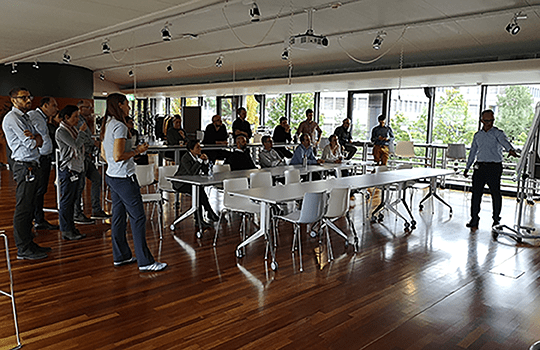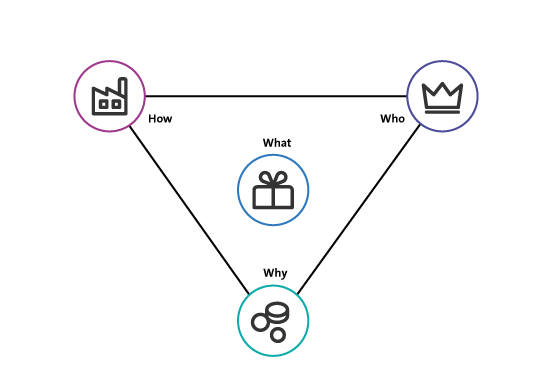The Power of Business Model Innovation
Though often neglected, business model innovation can unleash enormous benefits for business sustainability. Failing to shape your business for the digital age will ultimately pose a significant survival risk.
Text: Thomas Zasowski and Egon Steinkasserer, Pictures: Swisscom and Adobe Stock, 30 August 2021 10 min.
To support our business model innovation approach, we adapted the hackathon concept from the software developer’s world to the business model domain. It was here that the idea of a Swisscom business model hackathon was born. Our first effort with taking a business model hackathon approach resulted in a strategic realignment of the Swisscom Open Business Hub.
Business model innovation is one of the most exciting areas of innovation. In essence, the business model for a given product or service describes how profit is ultimately generated – in other words how an offering is transformed into cash. Hence it is no surprise, that changing the business model can have a major impact. In fact, business model innovation is one of the most value creating innovation types. Still it is often neglected even though it requires the lowest volume in effort when compared with product or process innovation.
A business model can be defined as a plan for the successful operation of a business, identifying sources of revenue, the intended customer base needs, products, and details of financing. The terms profit model and business model are mostly synonyms.
To innovate around a business model a deep understanding of what motivates customers when they consider buying a product or service is essential. Digitalization in the last 20 years has enabled new business models while on the other hand, new business models are often a mandatory foundation for digitalization. Furthermore, entire industries such as video entertainment and retail were turned upside down. Business model innovation, hence, is a catalyst for disruption. Companies like Netflix, Uber, Airbnb, eBay, or Google would not have become as successful and would possibly even cease to exist without new business models. Business model innovation is becoming increasingly important as profit models become obsolete faster than ever due to the exponential speed of global competition. Companies must be able to continuously innovate and explore new business models to reinvent themselves.
If businesses neglect to learn how to question and improve their successful profit model assumptions on a regular basis, they risk becoming obsolete quickly.

Fig. 1: Business Model Innovation is essential to survive
Not everyone is familiar with the term hackathon: Essentially it is an event with a specific focus that spans from multiple hours to a few days wherein computer programmers and/or hardware engineers and others involved in the product development collaborate intensively on software or hardware projects. The goal of a hackathon is to create functioning software or hardware by the end of the event. Hackathons in the last years have become very popular with Swisscom organizing and supporting countless internal and external hackathons.
Hence it might not be too surprising that we adopted the hackathon concept for an adjacent domain: business model innovation. In the following we would like to share with you the insights from our Swisscom business model hackathon for business-to-business (B2B) products and services.
Goals and Ideas
There were plenty of topics we were considering and some secondary goals we aimed to achieve as well. As there are a number of different units and customer segments that Swisscom interacts with regularly, we focused primarily on products and services for Swisscom business customers. In the beginning the following questions were top of mind:
- How can we make products more profitable driven by customer appreciation?
- How do we educate colleagues about existing business models elsewhere?
- How can we push the innovation mindset inside Swisscom and in particular among product managers?
- How can we foster and improve the collaboration and fruitful exchange between people with varying expertise and backgrounds?
These questions are of particular importance due to the unique scope of Swisscom’s business product portfolio and the intrinsic complexity associated with having this number of domains covered. Inspired by an engineering background and positive experiences, it was obvious to us that we should adapt the concept of a hackathon. However, the existing business model hackathon concepts did not fit our needs as they usually focus on developing new business model from scratch. In contrast, we wanted to revise current profit models of existing products and ideally reuse and adapt proven business models for the digital age. Hence, we had to elaborate our own concept for a business model hackathon.
Preparation
We began with agreeing to limit the number of participants to 25 employees. On top we invited a few experienced innovation managers from other parts of the company to enrich the discussion with unbiased views from outside our specific organization which included product managers from different product domains (mobile connectivity, IoT and banking) who volunteered to present their products and current business models and/or ideas. To encourage the out of the box thinking we decided to do the business model hackathon outside the usual office buildings in an environment stimulating creativity. At Swisscom, we have several modern creative spaces available, and our event took place in the so-called Bounty which makes you feel like you're in a big sailing ship instead of the regular office interior.

Fig. 2: Picture from the event on the Bounty
The participants had a very diverse background; therefore as we wanted to reuse proven profit models, we also needed to provide a bit of theory and introduced the Business Model Navigator(opens in new tab) (O. Gassmann et. al.), the Business Model Canvas(opens in new tab) (A. Osterwalder et. al.) and the Lean Canvas (A. Maurya) as common tools supporting the business model generation. Although all three models use different approaches, they have the following four main questions in common:
- Who is your target customer and market segment?
- What do you offer to your customers and what is your value proposition?
- Why is the business model profitable and what are the drivers for revenue and cost?
- How is the value proposition created and what partners, resources or activities are needed?

Fig. 3: The four main questions defining a business model
Well elaborated and detailed answers to those relatively obvious questions help to reduce the risks associated with creating or changing a business. In particular, it is crucial that customers are interested in the offering, that the service or product can actually be built and delivered and that there is solid financial planning with costs, revenues and profitability in mind.
With help of a business model canvas, an entire business model can be mapped into a pre-structured canvas comprising of nine essential building blocks. Different business model variants can be run through and examined in a structured and comprehensive way. The basic building blocks are:
- Value propositions: the customer problems that are solved as well as the value that is delivered to customers, e.g. cost reduction, performance increase, etc.
- Customer segments: people and organizations for which value is created, e.g. consumer market, niche market, industry vertical, etc.
- Customer relationships: the kind of relationship with the customers, e.g. self-service, personal assistance, co-creation, etc.
- Channels: touch points to interact with customers and deliver value, e.g. online, shop, distribution network, etc.
- Key activities: everything you need to execute, e.g. production facility, software platform, etc.
- Key partners: the ones you need to help you, e.g. suppliers, outsourcing partners, etc.
- Key resources: indispensable assets to create value, e.g. intellectual property rights, financials, experienced team, etc.
- Revenue streams: pricing mechanisms through which value is captured, e.g. subscription fee, one-of-payment, etc.
- Cost structure: costs associated for running the business, e.g. most expensive key resources and activities
More details as well as specific examples for the different blocks can be found in the whitepaper on the business model canvas(opens in new tab).
The Lean Canvas is an adaption of the Business Model Canvas for startups. It supports company founders by putting the customers’ problem into focus with potential solutions. Additionally, questions on the unique value proposition as well as on the unfair advantage can be elaborated. This way, the risk for startups of being easily copied by large corporates or other competitors can be reduced.
The Business Model Navigator is an approach to business model development and innovation developed by the University of St. Gallen. They have analyzed the most successful business models of the last decades and found that the majority of all business model innovations can be traced back to the combination of a number of basic patterns of successful business model innovations which is shown in an interactive way here.
These patterns can be used as templates to innovate your own business model by combining them and answering the four main questions concerning your business.
As the Business Model Canvas is very comprehensive and as the Lean Canvas targets startups mainly, we decided on the Business Model Navigator for the hackathon. It is constructed in a simpler way compared to the two aforementioned models and the business model patterns support a more structured ideation phase and foster reuse.
D-Day
We decided to invest one day for our first business model hackathon. We kicked-off the day with a short education session where we presented the above-mentioned methods. To further get the attendees in the mood and to motivate and challenge them on out-of-the-box thinking, we presented some successful examples of radical business model innovation, from companies such as Nespresso and Hilti. After an overview of the three products by their respective product managers we formed three hackathon teams – one per product. The idea generation in the three teams took most of the time and the outcomes were very different for each team. The selected approaches ranged from going through the business model patterns one by one up to having less structured brainstorming-like discussions. Using white boards and flip charts to discuss, combining and discarding ideas, each team came up with several potential business models.
In controversial discussions within the teams and also in the plenum, the pros and cons of the different proposals were debated, and the teams selected their preferred business model. One team even realized the need to pivot on their product as it did not solve the customers main pain points. Hence the team came up with a new value proposition as well as a new business model.
In the following pitch session, the teams presented their new business model to the whole audience. Many critical questions were asked on the proposals as well as on the underlying assumptions. On top, the audience enriched the presented business models with additional ideas and gave valuable feedback. This feedback was included by the teams which they used to refine their work hypothesis in a short session. In the final pitch session, the product managers showed the refined business models. Then they further explained what next steps would be necessary to implement the required changes.
Open Business Hub
One example for an idea that has been generated during the Business Model Hackathon and that has been successfully realized afterwards is the strategic realignment of the Open Banking Hub towards the Open Business Hub (OBH)(opens in new tab), which has gone live in the beginning of this year. The OBH is addressing two key challenges: the lack of standardization when it comes to integrating third-party providers into the systems of financial services providers, and the inability to connect multiple third-party providers for the same use case in a scalable manner. Swisscom offers an integration layer to support this, which companies can use to connect their systems efficiently with Swisscom’s Open Business Hub. To foster our commitment to the API economy we moved the Swisscom Open Business Hub as a B2B offering on the same platform as the Swisscom OneAPI Management exposed via the Swisscom Digital Marketplace(opens in new tab). We are convinced that in business ecosystems the co-existence of different hubs is essential. Thus we launched a first partnership with SIX(opens in new tab).
Learnings
The Business Model Hackathon format worked very well in general, and was also later confirmed by the positive feedback from all participants. The preparation and team discipline fostered by a good moderation paid off once again. Nevertheless, we also made some learnings that we want to share with you.
On the positive side, we stimulated the awareness for innovative business models, and we showed the participants methods on how to revise or create new business models. Also, we supported the product managers by creating three new business models for existing products, where most of the participants believed that they would be both beneficial for customers and more profitable for Swisscom than the current ones.
Reserving enough time is crucial. We did the whole hackathon in one day, which resulted in a need to hurry in most of the sessions to maintain the schedule. Distributing the sessions over two days would probably resolve this time pressure, while also leaving more time for elaboration of the business models in informal discussions breaks or ending the day with an apero. In addition, it is well known that for complex creative tasks, a night’s sleep increases the chance that we will wake up with a clearer view of the problem. The writer John Steinbeck stated that “a problem difficult at night is resolved in the morning after the committee of sleep has worked on it.”
The incorporation of the new and refined business models into the daily business was the most difficult part. As the products were in different maturity stages, it was more or less difficult for the product managers to adapt their product business models in a bottom-up way only. Some ideas could be realized as pitched during the hackathon while others were partly included and considered for the roadmap. In a next business model hackathon, we might also involve selected senior executives to have their buy in and have them take on a Godfather-type role for the immanent decisions and changes required. This would lead to a higher awareness and better support towards the implementation of the new business models.
While the setup was considered good for an initial business model hackathon, it needs to be adapted for future ones. For instance, for the level of education, it should be considered whether most of the participants have already participated such a hackathon or whether they are new to it.
We also made up our minds about scaling the business model hackathon idea. One idea that popped up was to establish business model ambassadors. These ambassadors should be previous hackathon participants supporting the generation of new business model ideas and (depending on their role in the organization) also aid with removing impediments or acting as a sparring partner and/or mentor to the product manager.
Thanks to the diversified composition of participants from across the company, the event also offers the added opportunity for team building. In the end, a great experience and overall success.
